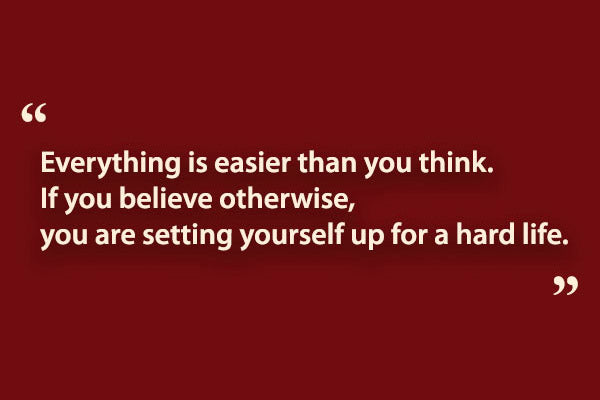In today's specialised world, many people are working hard to become an expert in something. Spending extensive time on any topic will turn a person into an expert in that subject just by sheer accumulation of knowledge. Sooner or later, some of such experts would find themselves in a position of teaching, training others to learn their techniques.
The problem is that most subject-matter experts would simply assume they know how to teach. Their main focus is on being a “content expert” as opposed to being a capable trainer. What keeps these trainers up at night is the worry of not having all the answers. What if they want to explain something and they suddenly forget what they wanted to say? What if they look like a fool? What if people are not convinced that they are indeed an expert on the topic?
Experts Are More Worried About Their Expertise
What’s fascinating, and rather sad, is that few worry about appearing as a poor trainer or not knowing how to teach. It is a curious thing to know where this confidence in teaching ability comes from.
Nevertheless, you get a lot of well-meaning experts who want to help and pass on their valuable knowledge, but don’t do an efficient job of teaching.
The potential damage for getting this wrong is enormous; you can put people off a topic, sometimes scar them for life. Just think about how many people you know recall that their math teachers were poor and so they stayed away from any subject to do with math. What a shame.
How to Be a Good Trainer
In order to become a good trainer, you can follow a number of fundamental principles. Learning them is not hard; the difficulty is to remember and adhere to these principles while teaching. You can explore such principles in our in-depth train the trainer guides.
Many trainers are susceptible to fall back to some poor training method they were exposed to themselves, or worse, make it up as they go along.
Whether you are already a seasoned trainer, or new to the training world, it pays to review these principles periodically and often in order to remember and apply them. This helps you to be conscious of them at all times.
A good way to learn these principles is to learn from bad examples. Rather than going through a to-do list, we like to highlight what leads to poor training. This way, it is easier to spot the behaviour and catch yourself in the act. You can immediately become conscious of it the moment you spot it and take steps to correct your behaviour.
The 10 Bad Beliefs of Training
What is listed here may sound logical and even obvious. The trick is to be aware of them at all times. This is much harder than it sounds and can take a long time to master. You must know these principles by heart.
Wrong Belief 1: Assuming Delegates Get the Idea the First Time You Explain it
Experts know the content well. A programmer has been programming for years. A Photoshop artist knows how to manipulate layers. A customer service expert knows how to handle difficult customers while still appearing supporting and positive. The problem here is they know the content so well they think it’s obvious. To a new learner, it is not. What happens then is that when it comes to training, they teach a given topic once and expect everyone to have understood and learnt it. They have forgotten how much they had to spend time mastering the skills themselves.
You must be gentle and patient with new learners and don’t assume they will get it straight away. Just assume that they won’t learn enough the first time you explain so that you don’t have any unrealistic assumptions.
Wrong Belief 2: Assuming Everyone Learns the Same Way
Experts are learners themselves. Everyone learns in a certain way. They may like to understand exactly what steps are required or talk it through with others. When it comes to teaching, most people think that the best way for their delegates to learn is the way they have learned themselves. You can imagine why this can be a problem. It takes the focus of the trainer away from the learner and instead encourages use of ineffective training methods.
Don’t teach the way you have learned. Understand how your delegates learn and match your teaching to it. Someone might learn by doing, someone might want to be told exactly what to do. You must understand these biases and respond to them accordingly. Considering that you are likely to find several learning styles in any given class, you must therefore have a variety of teaching methods to accommodate your delegates.
Wrong Belief 3: Treating All Topics Equally
Some experts believe that if they have three topics to teach in one hour, they should allocate 20 minutes to each topic. Wrong, very wrong! You must define how much time you spend on a topic, first, by how important it is, and second, by how long it takes to learn. All topics are not equal.
First think why you need to teach something and what your learners need. This tells you how valuable that topic really is. Next, ask yourself how difficult it is to teach or learn. Decide how much time you allocate based on these two important parameters.
Wrong Belief 4: Spending Too Much Time on Process
People who are new to training often try hard to get the training right. That is good intention and admirable. This means that they could spend too much time on process. They spend a good part of the training course telling you about health and safety, when you will have tea/coffee/lunch, how the Wi-Fi used to be easier to connect to before and now is a bit trickier, how you can login to the system to use the shared printer in the office next door when there is absolutely no need for it in this course and so on. This waste of time can put a big dent into the credibility of the trainer and subsequently make training much more difficult due to resistance of the delegates.
First, make sure people want to learn from you and are committed to your training before you tell them about process. If they are not convinced of your expertise or your ability to teach, why should they bother to know how this or that works.
Wrong Belief 5: Saying You Don't Know How to Explain
An expert explains a topic and a learner doesn’t understand. The expert explains it again and the learner still doesn’t get it. In despair, the expert declares, “Oh, I just don’t know how to explain this…” This is a disaster. Upon hearing this, the learner thinks that, if the trainer is struggling to explain this, surely, it must be a tough topic and well out of reach! An expression such as this by an expert means only one thing: “I am frustrated and frankly cannot be bothered to put any more effort in teaching you; I have ran out of ideas to get the point across.” You can imagine why this is a bad idea.
If you find some topics difficult to explain, you don’t have to tell that to your delegates. Instead, focus on understanding your learner’s learning style, finding a different way to teach or consulting a colleague who might have fresh ideas. Never put your hands up and declare you are defeated by the teaching task!
Wrong Belief 6: Passive Teaching
Experts, on the way to become expert, end up giving talks, presentations or short informative lectures. When they find themselves in the position of teaching a training course, they simply carry on with the same technique. In a training setting, most often the tools are similar; they would us a laptop, projector, whiteboard, tablet, etc. They therefore assume what they did before would work here and fall back to a one-sided information exchange. This is terrible for teaching. Passive lecturing is not teaching; it is informing people of a concept and hoping they go and learn it on their own. A training course where skills transfer takes place is very different.
If you want people to learn something, you must make them think. There is no other way. Adults learn by assimilating current knowledge and associating it with existing knowledge. With a passive teaching you don’t trigger this assimilation and self-learning. No one would remember your course, so don’t waste your time.
Wrong Belief 7: Repeatedly Explaining What You Know Best
Experts often talk more about topics they like and know more about than others. Instead of thinking what’s important to learners, they can easily get carried away with exciting topics they cannot get enough of and keep focusing on talking about those. Other times, they find teaching a particular topic easier than other topics. Again, they keep spending way too much time to teach these while ignoring other potentially more important topics.
Know your priorities. Do not follow a training path just because it is easy for you or because it is your favourite. Think what your learners need at any given point in their development, and work hard to make them progress forward.
Wrong Belief 8: Testing Learners Before They Get a Chance to Practice
Some experts are eager to see their learners succeed. That is noble, but some do so at the expense of the learner. They teach a topic and before the leaner had a chance to absorb or practice the skill, they question and test the poor learner. They think, by putting pressure, appearing tough and expecting a lot, they make the delegate pay more attention and learn quicker. The opposite is much more likely. The expectation placed on learners simply puts them off learning.
Before testing or challenging your learners make sure you have given them ample time and chance to practice.
Wrong Belief 9: Not Sharing Everything You Know Because of Ego
Some experts view their new learners as their potential future competitors. That’s backward thinking. If you like your topic, know enough, and like to teach, then don’t hold back. Your delegates will find out what you left out sooner than you think—especially in this information rich era. Gone are the days where you could hoard information, keep it in the family, like blacksmiths, for generations. Now, everyone on the planet has access to most information. Don’t let your ego get in the way of your teaching.
Give freely and enthusiastically. This is much more rewarding to you morally and psychologically than the value of holding back any information for however long you can.
Wrong Belief 10: Punishing Learners for Wrong Answers
Some experts have an image in their head that in order to be a good trainer, they must be tough. They must appear dismissive and hard to please. The problem with this is that learners get trained that there is no hope, that they will never succeed or get anything right. Naturally, they pay less attention, avoid the topic and the expert or even the whole field.
Adults don’t put up with misery for long; punishing them and making life tough is a sure way to put them off of you and potentially the field. Your career as a teacher will be short lived for sure. Instead, focus on rewarding your learners for giving the right answers and make them excited to learn more. If delegates didn’t get it right, find something they can get right and reward them for it. Then, build up from this happy base.
Soft Skills Training Materials
Get downloadable training materials
Online Train the Trainer Course:
Core Skills
Learn How to Become the Best Trainer in Your Field
All Tags
Training Resources for You

Course Design Strategy
Available as paperback and ebook

Free Training Resources
Download a free comprehensive training package including training guidelines, soft skills training activities, assessment forms and useful training resources that you can use to enhance your courses.

Our Comprehensive Guide to Body Language

Train the Trainer Resources
Get Insights - Read Guides and Books - Attend Courses
Training Materials
Get downloadable training materials on: Management Training, Personal Development, Interpersonal Development, Human Resources, and Sales & Marketing














Leave a comment
All comments are moderated before being published.
This site is protected by hCaptcha and the hCaptcha Privacy Policy and Terms of Service apply.